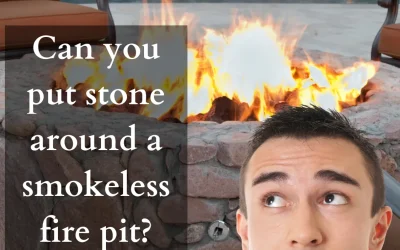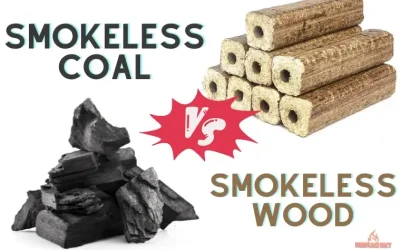In the world of fire pits, the battle between whether to burn wood or Smokeless fuel is heating up! Smokeless fuels have gained popularity due to their many benefits, but is it worth giving up the classic wood-burning experience?
In short, some smokeless fuels shine brighter than others, offering far superior heat production and minimal smoke. These superstars outperform wood in many aspects, making them a top choice for a fire pit. But fear not, if you love that authentic wood-burning feel, I’ve got something special for you too.
Wood has long been known for its impressive heat output, but the smoke can be a major drawback. Nobody wants to be enveloped in smoke when enjoying a cozy evening around the fire! Enter smokeless fuels, the game-changer that promises a smoke-free and delightful experience.
Throughout this article, I’ll explore the various smokeless fuel types and how they compare to wood in different aspects of fire pit performance. From Natural Fiber Logs to other innovative options, let me help you find the perfect match for your perfect smokeless fire pit.
No more guesswork! I’ll guide you to choose the ideal smokeless fuel type that fits your preferences and makes fire pit maintenance a breeze.
Burn wood or smokeless fuel : Comparison Table
So how does wood compare with Smokeless fuel types, I hear you ask! Let’s dive in.
Here’s a rough comparison of different fuel types and how they rank against each other in aspects that are most important to using them as fuel.

| Aspect | Wood | Bioethanol | Propane | Natural Gas | Gel Fuel | Denatured Alcohol | Natural Fiber Logs | Electric |
|---|---|---|---|---|---|---|---|---|
| Smoke Production | High | Low | Low | Low | Low | Low | Low | None |
| Heat Production (BTU Value) | Varies | 3,412 per lb | 91,500 per gal | 1,000 per cu ft | 3,000 to 5,000 per can | 12,500 to 14,000 per lb | 3,000 to 7,000 per hr | Measured in watts |
| Odor | Distinct wood smoke smell | Negligible | No odor | No odor | No odor | Alcohol-like smell | No odor | No odor |
| Environmental Impact | Carbon emissions, deforestation | Renewable, low emissions | Low emissions, non-renewable | Low emissions, non-renewable | Low emissions | Renewable, low emissions | Renewable, low emissions | Zero emissions |
| Fuel Availability | Readily available | Readily available | Readily available | Requires gas line connection | Readily available | Readily available | Readily available | Dependent on electricity |
| Storage and Handling | Requires space for wood storage | Easy storage and handling | Portable tanks, easy handling | Connected to gas lines | Easy storage and handling | Easy storage and handling | Easy storage and handling | No fuel storage required |
| Convenience | Requires firewood preparation | Ready-to-use fuel | Readily available | Readily available | Ready-to-use fuel | Ready-to-use fuel | Ready-to-use fuel | Switch on/off |
| Ease of Use | Requires fire building skills | Simple, pour and ignite | Simple, turn on and ignite | Simple, turn on and ignite | Simple, light and ignite | Simple, pour and ignite | Simple, light and ignite | Simple, plug and switch on |
| Safety | Risk of sparks, handling fire | Low risk, controlled flames | Low risk, controlled flames | Low risk, controlled flames | Low risk, controlled flames | Low risk, controlled flames | Low risk, controlled flames | No open flames, safe |
| Maintenance | Cleaning, ash disposal | Minimal maintenance | Minimal maintenance | Minimal maintenance | Minimal maintenance | Minimal maintenance | Minimal maintenance | Minimal maintenance |
| Cost | Inexpensive | Moderate | Moderate | Moderate | Low to moderate | Inexpensive | Moderate | Moderate |
| Cooking Use | Suitable for grilling and cooking | Not recommended for cooking | Great for grilling and cooking | Great for grilling and cooking | Not recommended for cooking | Not recommended for cooking | Not recommended for cooking | Not recommended for cooking |
| Portability | Requires transportation of wood | Portable, easy to transport | Portable with tanks, easy to transport | Requires gas line connection | Portable, easy to transport | Portable, easy to transport | Portable, easy to transport | Portable, easy to transport |
Related : How Does a Perfect Smokeless Fire Pit Work?
How do you measure the Heat Production when you burn wood or smokeless fuel?
Measuring heat output from different fuel sources can be challenging without specialized equipment. But, there are a few general methods you can use to compare the heat output of fuel sources:
- BTU (British Thermal Units): BTU is a standard unit of heat measurement. You can look up the approximate BTU values for different types of fuels, such as wood or specific smokeless fuels. Comparing the BTU values can give you an idea of the heat output potential of each fuel.
- Observational Comparison: You can observe and compare the intensity of the flames and the heat radiated by each fuel source. This method is subjective and less precise, but it can provide a qualitative assessment of the heat output.
- Heating Duration: Compare the duration of heat produced by each fuel source. Some fuels burn faster than others, so if one fuel burns out quickly while the other continues to provide heat, it indicates a higher heat output from the fuel that lasts longer.
Heat output can also be influenced by things like the fire pit design, airflow, and how the fuel is ignited and maintained. Additionally, different types and brands of smokeless fuels can have varying heat output characteristics. For more accurate and precise measurements, specialized equipment like calorimeters can be used to measure the heat output in terms of BTU or other metrics.
In practice, it’s often helpful to rely on available information, such as manufacturer specifications or user reviews, to get an idea of the heat output for specific fuels or to consult with experts or retailers specializing in fire pit fuels for more detailed information.
How is Smoke Production Measured?
Unfortunately, there’s no fancy smoke-o-meter or smoke scale involved. Instead, it’s more of a visual and sensory experience. Some ways to assess smoke production are:
- The Smoke Cloud Spectacle: Picture yourself as a smoke detective, observing the density and color of the smoke clouds. Fuels that create thick, dark smoke clouds may earn the title of “smoke machines,” while those producing wispy, light clouds could be deemed “masters of disguise.”
- Sniffing Out the Smokiness: Your nose becomes the ultimate smoke sniffer. Take a whiff and see if there’s any smoky scent accompanying the smoke. Some fuels may have a strong aroma, like the scent of a backyard barbecue or a bonfire beach party.
- Environmental Smoke Impact: Imagine a superhero cape representing environmental consciousness. Consider how much smoke and harmful emissions a fuel releases into the air. The less smoke and pollution, the greener the fuel superhero becomes.
Remember, these approaches capture the essence of evaluating smoke production in a fun and imaginative way. While there may not be a scientific smoke-measuring device, your keen senses and observation skills can help you determine the smoke prowess of different fuel types.
In what situation is having a normal wood burning better than using smokeless fuel?
Having a traditional fire pit, as opposed to a smokeless fire pit, can be preferable in certain situations:
- Outdoor Settings: In open outdoor settings with ample ventilation and space, a traditional fire pit may be more suitable. The smoke produced by the fire can disperse easily, minimizing any potential discomfort or inconvenience caused by smoke.
- Wood-Burning Experience: Some people enjoy the authentic experience of gathering around a wood-burning fire pit, including the crackling sound and the aroma of burning wood. Traditional fire pits allow for the use of wood as fuel, creating a cozy and nostalgic ambiance.
- Cooking and Grilling: Traditional fire pits often provide a larger surface area and more flexibility for cooking and grilling. They can accommodate accessories like grates, rotisseries, or cooking utensils, allowing for a variety of outdoor cooking options.
- Lower Cost: Traditional fire pits can be more cost-effective compared to smokeless fire pits, especially if you already have access to firewood or if you prefer the simplicity of wood as a fuel source.
- Rustic Aesthetic: For those seeking a rustic or natural aesthetic in their outdoor space, a traditional fire pit with its open flame and wood-burning characteristics can complement the desired ambiance.
It’s important to note that traditional fire pits may produce more smoke and require proper ventilation to prevent smoke from becoming a nuisance. Additionally, local regulations and restrictions regarding open fires should always be considered when choosing between a traditional fire pit and a smokeless fire pit.
Related : Build Your Own Smokeless Fire Pits With These 3 Methods
FAQs
What type of wood is cheaper to burn in a fire pit?
The cost of wood can depend on several things like the region you live in, availability, and local market conditions. In general, softer woods tend to be more affordable compared to hardwoods. Softwood varieties like pine, spruce, fir, and cedar are typically cheaper to purchase or buy compared to hardwoods like oak, maple, birch, or cherry.
Softwoods often grow faster and are more readily available, leading to lower production and transportation costs. Additionally, softwoods tend to have a higher resin content, which allows them to ignite and burn more easily. However, it’s important to note that softwoods also burn faster and may require more frequent refuelling compared to hardwoods.
If you are looking for a cost-effective option for burning wood in a fire pit, consider exploring local sources for softwoods. You may be able to find firewood suppliers or tree services that offer affordable softwood options. Additionally, collecting fallen or cut wood from your own property or nearby areas can be a cost-effective and sustainable approach, as long as it’s legal and follows local regulations.
But make sure to always ensure that the wood you burn is properly dry to optimize burning efficiency and reduce smoke and pollutants.
Summary
So, is it better to burn wood or smokeless fuel? Hands down, Smokeless Fuel wins the argument. Natural Fiber, Bioethanol and Propane are 3 of the most popular options out in the market whether you’re building your own smokeless fire pit, or buying a branded fire pit.










